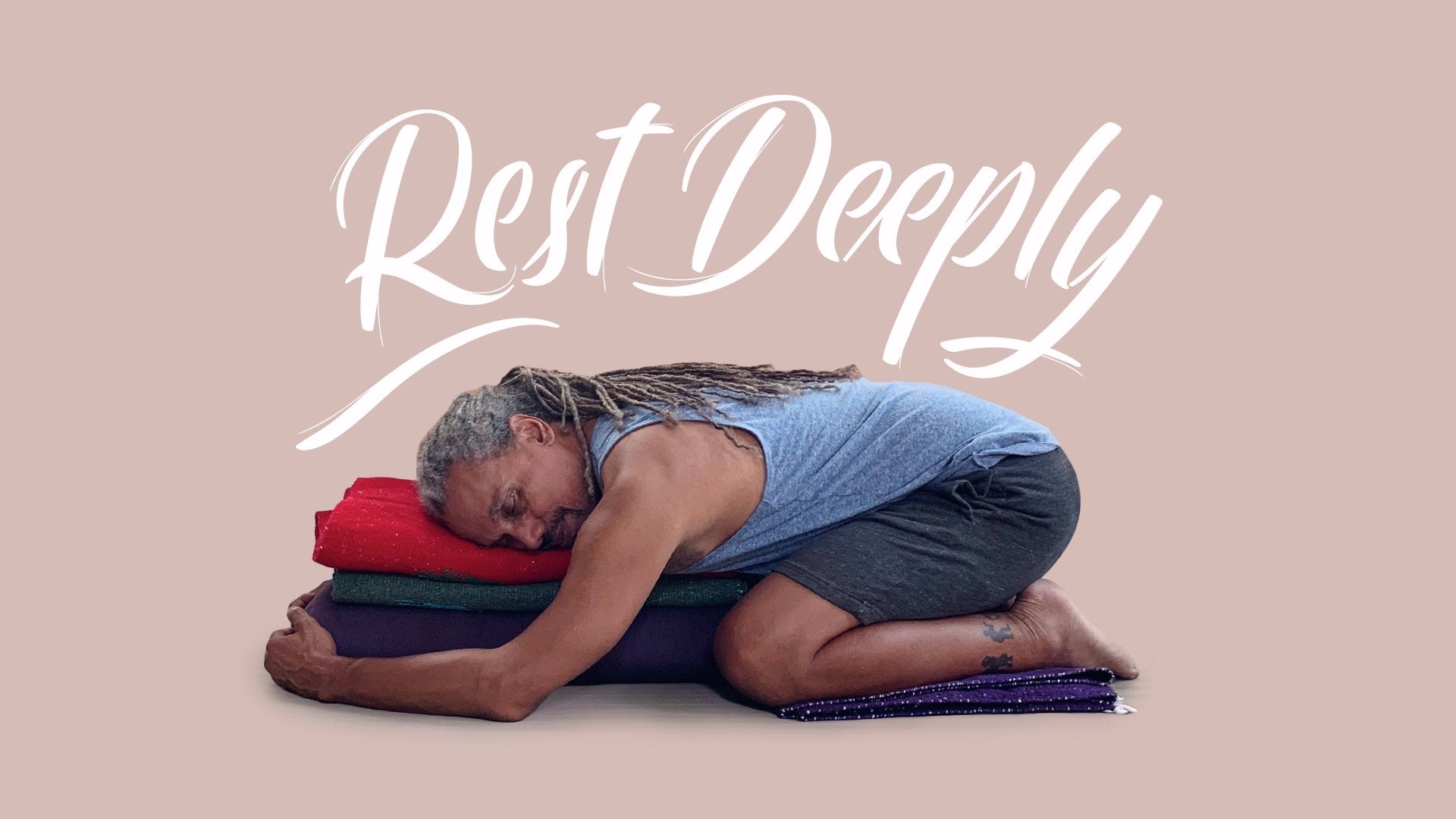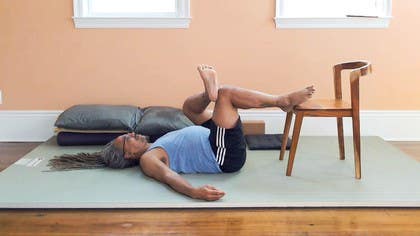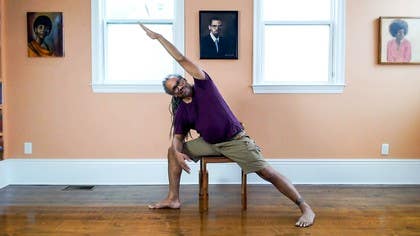Description
About This Video
Transcript
Read Full Transcript
For this practice, we're going to focus on tonifying the kidneys. The kidneys in Chinese medicine are kind of like the underlying power source for all the other functions of the body. And they get really depleted with emotional strain, especially the emotions of fear and fright. So we're going to do what we can today to tonify and strengthen the kidneys. So sitting up, find a comfortable seat.
I have a block underneath my hips so I can have my knees a little bit lower than my hip joints. And I'm not sitting like this, which is a little hard on the low back and the kidney area. So my knees are a little lower than my hips. And bring your hands to your knees and we're going to do some belly breathing, drawing the breath into the low belly. And as we inhale, we're going to stick, arch the low back, stick the booty out and lift the heart a little bit.
And as we exhale, hook the fingers on the knees, tuck the tailbone and drop the chin towards the chest. As you inhale, arching the low back, lifting the heart, lifting the gaze slightly. As you exhale, tucking the tailbone, rounding the back, dropping the chin towards the chest and following the movement of your breath. Each inhale opens the front of the heart. Each exhale opens the back of the heart.
Make some space between your shoulder blades. Inhaling, lifting the heart, arching the back, looking up slightly. Exhaling, hooking the knees with the fingers, leaning back into that support to open the back of the heart. Many more times, getting a nice wave-like movement that starts in your breath and moves through your spine, the whole length of your spine. Breathing out as you breathe in, breathe into the belly and lift the heart.
Make space for the inhale and exhale, rounding. Next inhale, come to sitting up tall, sitting up straight, and then we're going to take the rib cage and see if we can get the rib cage to move in a circle. So first start by shifting the ribs to one side and then shift them back. You'll tuck the tailbone as you shift them back a little bit. Shift them to the other side and then shift them forward, and here you're arching the low back a little bit, side, back, side, forward, and notice, are you breathing?
If not, then start. So we've been doing it with kind of corners. Now see if you can round it out and connect the movements. As you take your rib cage in some slow, smooth circles, basically massaging our kidneys, massaging our internal organs with movement, and then come back to the center and we're going to go the other direction. So shift the ribs to the side.
Let's go back to the boxy movement. Shift them back to the other side and shift them forward, shift them to the side, back, other side, forward, back, other side, forward, side, back, other side, forward, and now see if you can connect them and make it a smooth transition to the side, to the back, to the other side, and forward, massaging your internal organs, massaging your kidneys, which are located in your low back, just below the bottom ribs, just in front of the bottom ribs. And in Chinese medicine, the kidneys are really connected in with most back pains. Usually some sort of kidney deficiency leads to low back pains, according to Chinese medicine. And then coming back to the center and then do two in one direction, two in the other direction and go for this smooth ossity, go for a really smooth and round movement.
One lap, second lap, and reverse, one lap, second lap, and reverse. And when I do this on my own, when no cameras are in the room, I will moan and groan as I do this, because it's getting into this part of the back, the sides of the low back that don't really get to move that much. And the motion, the sound of the moaning and groaning is movement. That vibration helps to cause movement in all the layers of your body mind. One more time.
And back to the center. Take a pause here at the center and take a few belly breaths. And you can open your eyes. And I'm going to come off of my throne and set my block to the side. And then we're going to come this way and come into a child's pose.
So what I have here is a bolster or you can use a couch cushion. And I have three layers of towels stacked on top of that and then a pillow on top of that. I am going to use another pillow underneath my knees for a little extra padding. So I'm going to come here on hands and knees, bring my toes together and my knees apart. And then set my hips down towards my heels.
If that is not comfortable, I can take a little weight off of my knees, some pressure off of my knees by setting a bolster, a bolster, a block between my knees. Toes together, knees apart and set my weight onto the block. I'm going to hug this in, draw this support in right in between my knees. Inhale, get really tall and exhale, I'm going to walk my hands forward and bring my heart onto the support of the bolster. If my neck is not comfortable turning, I can make a pillow with my forearms and let my forehead rest on the wrists, no point down.
Otherwise if I'm comfortable turning my head, I can turn my head to one side. If this is too low, you can always bring another couple of towels in here or another couch cushion underneath your squishy soft pillow, lengthen up and then come forward. For me, that's a little high, so I'm going to come back down where I was. Once you get comfortable in the pose, notice what your elbows are doing. If your elbows are propping yourself up, try taking your elbows a little out to the side so that your heart is resting into the support of the cushions and towels and pillows.
We're going to hang out here for a couple of minutes while you're here, take a few deep low belly breaths. As you take some deep belly breaths here, notice how your low back expands. This is a great way to massage the area of the kidneys. You can even bring the intention into your breath of breathing into your low back, breathing into your lowest ribs, breathing right into your kidneys and breathing out from your kidneys on the exhale. In about five to ten deep belly breaths.
One, two, three, four, five, six, seven, eight, nine, eight, nine, ten, ten, ten, ten, ten, ten, ten. And if you have your head turned to one side, you can slowly lift up a little bit and turn your head so you twist your neck to the other side. If you have your nose going straight forward, you can just hang out with the nose forward with support underneath the forehead. As you settle into the second side, take about five to ten slow deep belly breaths. One, two, three, four, five, six, seven, eight, nine, ten, ten, ten, ten, ten, ten, ten, ten, ten, ten.
Eventually releasing any effort with your breath and just melting into the pose. And deepening your breath again. Slide your palms in down onto the floor and shift your hips forward so you come into hands and knees position. And then you can slide this stack out from underneath your chest. Slide it out of the way. If you have a block underneath your hips, you can slide that out of the way. And then hands and knees, we're going to take one leg back, straighten it out, tuck the toes, and then shift back. So we're pressing back through the back heel just to stretch the knee in the opposite direction. Stretch the calf muscles a little bit. If this is too much on your wrists, you can slide that stack back in front of you crosswise. Come onto your forearms like you're doing a plank position and do the same thing. This is a lot easier on the wrists and also makes your shoulder muscles work a little harder. And then slowly release that, bringing that knee down and extending the other leg out, tucking the toes, and shifting the weight back towards the heel to stretch into the calf muscles and breathe. And then slowly releasing that. Set your props to the side if you use them. I'm going to slide this blanket up, this pillow up here in case I need it. I might not need it. And I'm going to come and sit and face my chair. I want to end up with my calves on the chair and what people usually do is try to pick it up like that. That's really hard. I'm going to sit side saddle and then roll onto my back and bring the legs up onto the chair. I want my body kind of centered in the center of the chair and I can feel how my neck is. Do I need a pillow under my head? For my body that feels a little high. If it feels good for your body, you can stick with it. I can tell I need to be in a little closer and we do want something soft underneath the calves, especially on the edge of the chair that's close to your calf muscles. We're going to do a little hip stretch here. So I'm going to cross one ankle over the opposite knee and I can stay here or I can bring my foot up to the edge of the chair. This is sometimes called thread the needle pose or figure four pose. Oftentimes we're doing this by reaching the hands through, but I like doing it with the chair or with a wall because you can relax the hands and hang out in the stretch for this hip. Notice your breathing. A lot of times when we start to stretch the outer hips, the breath gets bound. If your breath is bound, it means you're stretching too far. Ease off a little bit and the way to ease off would be to scoot a little further from the chair or the wall. And then from here keeping the same cross of the legs, you can turn towards the sole of this foot just a little bit and see if that changes this angle and stretch into this hip, into this booty. Check in with your breathing.
Are you still able to breathe easily in and out and slowly come back to the center on cross. Take a pause with the legs out straight. I can tell the chair slid away from me a little bit. And then bring the feet back to the edge of the chair, crossing the other ankle over. I'm going to slide it away on purpose now because this side is tighter, quite a bit tighter for me. And checking in with the breath again. As your breath moves in and out easily across your body, you can bring that intention to breathing into the low back, maybe even breathing into the area of the hips where you feel the stretch. And then taking the knees towards the sole of this foot just a little off to the side and we'll get a different line of stretch through this outer booty. Always checking in with your breath. And slowly coming back to the center and uncrossing the legs. And then here the chair is slid away again so I'm going to slide it in just a little bit. When I bring my legs up onto it, I want my thighs kind of close to vertical-ish. They don't have to be exactly vertical. I can tell I need them to come in, need it to come in a little more. Bring my legs up and find the perfect position where your lower legs are completely supported by the chair, your hips can and just relax. Your tailbone and pelvis and sacrum can drop down towards the floor and you can breathe into your low belly and low back. Take at least five slow deep belly breaths. For the next few breaths, imagine that you can breathe into the low back. Your low back is resting on the earth and the earth is a very great source of the in energy that nourishing energy. You can breathe that earth energy into your kidneys, into your low back and breathe out whatever you're ready to let go of. It can be helpful to make a little as you exhale for the next few breaths. Letting the weight of the head be heavy, the jaw soft, hands and arms relaxed.
Letting go of the effort with your breath, and just resting with your legs supported. Hear a weight sinking into the floor. Jaw and head heavy. And you're welcome to stay here with your legs up the chair. And if you're ready to come out of the pose, deepen your breath. Bring some movement into the legs and hands. And draw one knee at a time up towards your chest. And then slowly roll on to your side and take a pause on your side. You can either use your arm as a pillow or grab a hold of one of your pillows and slide it underneath your head and neck. And slowly roll forward. Let your head stay heavy. Slowly coming on up to find a comfortable seated position. Sitting up tall with your shoulders relaxed down away from your ears. Bring the palms together, hands in front of your heart. Namaste.
Rest Deeply
Comments
You need to be a subscriber to post a comment.
Please Log In or Create an Account to start your free trial.












